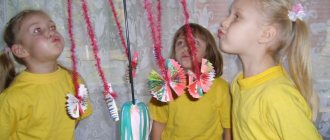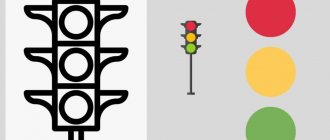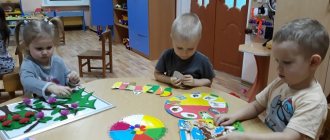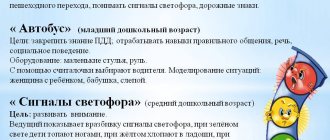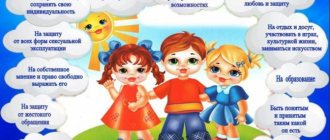The purpose of the didactic game “Professions”
The goal of the game is to expand and consolidate ideas about all kinds of professions, their characteristics and importance for society, the working tools used, and the products produced.
Game objectives:
- remembering the names of professions;
- expanding knowledge about the tools and devices needed to perform professional duties;
- clarification of the purpose and characteristics of professions;
- clarifying the idea of where people work, what clothes they wear, what actions they perform, and what their workplace looks like;
- developing an idea of what employees should know and be able to do;
- fostering a respectful and grateful attitude towards the work of others;
- developing an understanding that every profession is important, and the results of work are of great importance;
- instilling the desire to work hard and become a good worker;
- development of speech skills, the ability to think logically and perceive information by ear.
Didactic games “Professions” in the senior group
Preschoolers in the older group should already know a wide range of professions, as well as have an idea of the professional responsibilities of different workers and the tools they use.
List professions starting with the selected letter
The teacher places cards with letters face down on the table. Children take turns coming to the table, taking a card, calling professions that begin with the chosen letter:
- A – actor, agronomist, astrologer, administrator, aviator, lawyer, architect, obstetrician;
- B – accountant, bookseller, bartender, banker, accordion player, librarian, ballerina, boxer;
- B – doctor, makeup artist, driver, diver, teacher, veterinarian;
- G – geologist, governess, loader, make-up artist;
- D – janitor, conductor, designer, nutritionist, truck driver, milkmaid, dispatcher, director;
- F – livestock breeder, journalist, jockey;
- Z – sound engineer, zoologist, manager;
- I – inspector, engineer, inventor, art critic, illustrator, historian;
- K - astronaut, clown, captain, combine operator, composer, cashier, fireman, blacksmith;
- L – laboratory assistant, pilot, lumberjack, speech therapist;
- M – driver, fashion model, painter, nurse, meteorologist, mechanic, installer, musician;
- N – nanny, notary, oil worker;
- O – ophthalmologist, waiter, operator, landscaper, security guard;
- P – shepherd, cook, pediatrician, writer, hairdresser, pianist, carpenter, postman, salesman;
- R – director, radio operator, fisherman, reporter;
- S – secretary, plumber, gardener, violinist, mechanic, sculptor, dentist;
- T – tractor driver, turner, chimney sweep, trainer;
- U – cleaner, teacher, scientist;
- F – photographer, florist, pharmacist, farmer, philosopher, football player;
- X – surgeon, artist, choreographer;
- Sh – miner, seamstress, driver, plasterer;
- E – ecologist, electrician, tour guide, economist, excavator operator;
- Yu is a lawyer, cabin boy, jeweler.
What is this builder called?
The game introduces preschoolers to construction professions. The teacher says what the person does, and the children answer what they call him:
- paints walls - painter;
- covers the roof with tiles - a roofer;
- builds a house from brick - mason;
- connects metal parts - a welder;
- lays tiles on the walls - a tiler;
- makes the walls smooth, applies plaster - plasterer;
- makes parts from wood - carpenter.
Name your profession based on the result of your work
The teacher shows the pupils cards depicting the result of the work, and they must guess who is doing the work. For example, the picture “suit” is the profession “seamstress”. Or “cake” – “confectioner”. Or “house” – “builder”.
Name the extra item
The teacher places in front of the children 4 illustrations of tools used by certain workers. One of the items is superfluous, it must be pointed out with an explanation of the reason for the choice. For example, “trowel”, “helmet”, “drill”, “syringe” - the first three are used by a builder, the last item is used by a nurse.
Ambulance
The game forms in preschoolers an idea of the importance of the medical profession. For the lesson, you need to prepare pictures depicting the tools and consumables that emergency personnel use: a syringe, bandage, iodine, thermometer, bandage, etc.
During the game, different situations are considered. One child plays a doctor, the second plays a patient. The second one tells what problem he has: a broken knee, a scratched hand, bleeding from the nose, sore throat, headache, etc. The child playing the doctor tells what tools and medicines he will use in each specific case. If necessary, the teacher prompts him.
Pharmacy
A role-playing game introduces preschoolers to the profession of a pharmacist. For the lesson you need to prepare pictures depicting medicines and cards imitating “money”. Children distribute roles. One becomes a pharmacist at the cash register, the rest become customers. The roles alternately change.
Customers take turns “entering the pharmacy.” They say that they are worried about whether the medicine they need is available. The pharmacist offers the buyer a product and collects payment. The teacher helps the players, gives tips on prescribing medications, and asks leading questions.
Didactic games “Professions” in the middle group
The task of a teacher in the middle group is to expand and consolidate students’ knowledge about different professions, develop their thinking ability, concentration, ability to navigate, and give clear and competent answers.
What to whom?
To get acquainted with professions, the presenter names the worker, and the children must list the tools, devices and materials that he uses:
- doctor - syringe, stethoscope, medical gown, rubber gloves, bandage, medical card;
- builder - drill, hammer, bricks, boards, helmet, concrete, nails, saw;
- teacher - pointer, class magazine, textbooks, wall maps, blackboard;
- artist - paints, brushes, canvas, palette, easel, paper, pencils;
- cook - dishes, oven, blender, cap, apron, food, recipe book;
- hairdresser - hair dryer, combs, scissors, curling iron, hair dyes, hairpins, mirror;
- gardener - rake, gloves, shovel, seedlings, lawn mower, pruning shears, watering can;
- seamstress - sewing machine, iron, ironing board, scissors, fabric, needles, threads.
This is true?
For the game you need to prepare pictures depicting people of different professions in appropriate attire. Each player receives two cards: red – the answer is “no”, green – “yes”.
The presenter shows the children a picture and says who the person drawn works for. Players must understand whether what is said is true and raise the appropriate card. For example, the presenter, showing a picture of a fireman, says: “This is a teacher.” Children hold up a red card.
Work clothes
To play, you need to cut out paper images of a girl and a guy, as well as different work clothes.
The teacher says that the paper characters are going to go to work, but they need help choosing the right suit. The game can be built in different ways. The teacher names a profession, and the children choose the correct one from a heap of paper clothes. Or the teacher chooses the costume himself, and the players name the character’s place of work. When the children have sorted out their work wardrobe, the teacher asks them to close their eyes to consolidate the acquired knowledge, and he himself rearranges the clothes and asks them to find the mistake.
Work transport
To play, you need to arrange chairs and attach to each chair an image of a specific car: ambulance, fire, police, bus, plane, train and others. And cut out “steering wheels” from cardboard with professions written on them.
The presenter gives each player a steering wheel and names their profession. The player must find his “car”, sit on a chair, steer, “going to work”. The game is repeated, the presenter changes the players' steering wheels.
For a cook or a doctor?
This didactic game “Professions” for kindergarten systematizes ideas about the work responsibilities and professional characteristics of a cook and a doctor.
Two children are playing: one is a cook, the other is a doctor. The presenter pulls items out of the bag and asks which worker needs them. For example, a doctor needs a syringe, a cook needs a spoon. Children should not just answer, but explain why the employee needs this item.
Game "Who needs it?"
Target
.
To consolidate children’s ideas about objects and their use in work processes. Introduce professions. Progress of the game:
The teacher shows the children various objects, asks them to name them and tell them when they are used and for what purpose. For example: this is a ladle, the cook needs it to stir porridge, pour soup and compote, etc. When playing a game with children of senior preschool age, the teacher selects different pictures depicting objects. For example: pliers, hammer, vacuum cleaner, coffee grinder, steering wheel, computer, microphone, drawing board, centimeter, microscope, telescope, jackhammer, etc. Children name the profession of the person who uses the depicted object in his work.
Game "Choose a job"
Target
.
To give children a basic understanding of the professions of people whose work was not in the sphere of their observations. Arouse interest in the work of people of any profession. Progress of the game:
The teacher, together with the children, gets up in a round dance and invites them to walk in a circle, saying: Let us grow up together and choose a job. We will become astronauts and fly rockets. (Children imitate the sound of an engine and the flight of a rocket, following the teacher’s instructions.) We will become captains, we will lead ships. (Children show how the captain looks through binoculars.) Let's go to helicopter pilots, let's fly helicopters. (Children run and make circular movements with their arms above their heads.) The game can be continued with older children; they already independently imitate the appropriate actions. And we will become pilots, we will fly airplanes. The first two lines are repeated at the beginning of each verse, the children walk in a circle to these words. We will go to combine harvesters and drive combine harvesters. We'll go to the fire department and start putting out the fire.
The game “Why (why, why) do you need to do this?”
Target
.
To form in children an idea of the need for labor, to expand knowledge about labor processes. Progress of the game:
The teacher shows the children a picture depicting an object that characterizes a particular action. Children must name this action. - Why do you need a plant? (Water can.) - Why do you need to feed? (Bird.) - What needs to be washed? (Plate.) - What needs to be cleaned? (Carpet.) - What needs to be washed? (Dress.) - What needs to be ironed? (Shirt.) - What do you need to bake? (Pies.) - What needs to be changed? (Bed linen.) - Who needs to be bathed? (Child.) Children of older preschool age are asked more difficult questions. - Why sow fields? (Grain.) - Why plant? (Potatoes.) - Why spray? (Apple tree.) - Why buy bread (milk, sausages, fruit) in the store? — Why repair a broken toy? — Why do weekly cleaning of the apartment? - Why take care of your body?
DIDACTICAL GAMES ON LABOR EDUCATION FOR CHILDREN AGED 5-7 YEARS OLD
Game "Guess what I'm doing?"
Target
.
Expand children's understanding of work activities. Develop attention. Progress of the game:
The teacher and children join hands and stand in a circle. A child comes to the center of the circle. Everyone goes in a circle and says: We don’t know what you’re doing, Let’s take a look and guess. The child imitates labor actions not only with movements, but also (if possible) with sounds. For example, he cleans the floor with a vacuum cleaner, hammers a nail, saws, drives a car, does laundry, carries a bucket of water, wipes a mirror, chops wood, grates, turns something in a meat grinder, etc. Children guess the actions.
Game “What first, what then?”
Target.
Clarify children's knowledge about the rules of replanting indoor plants.
Progress of the game:
The teacher shows the children pictures depicting the stages of replanting indoor plants and asks them to arrange them in the order in which the actions are performed. • A pot is overturned and the plant is removed from it. • Washing the potty. • Laying pebbles at the bottom of the pot. • Pour sand into the pot (height 1 cm). • Pour some soil into the pot on top of the sand. • Shaking off old soil from the roots of the plant with a stick. • Cutting off rotten roots. • Planting the plant in a pot so that the transition point between the stem and the root is on the surface, and covering it with soil. • Compaction of the earth. • Installing a pot with a plant on a pallet. • Watering the plant at the root.
Game "Name the profession."
Target
.
Teach children to correctly name people's professions by the types of cars they drive. Progress of the game:
The teacher names cars, vehicles and other technical means, and the children name the professions of the people who drive them. Tractor - tractor driver. The car is a driver. Excavator - excavator operator. Combine - combine harvester. Crane - crane operator. Train driver. The ship is the captain. Airplane - pilot (pilot). Spaceship - astronaut. Fire truck - fireman. Bulldozer - bulldozer driver. Racing car - racer (pilot). Etc.
Game "Guess the profession."
Target
.
Expand children's ideas about professions. Progress of the game:
The teacher shows the children an object picture. Children name the profession of the person in whose work this object is used or is the result of his work. Rabbit is a rabbit breeder. Calf - calf. Sheep is a sheep farmer. Deer - reindeer herder. Grapes - winegrower. Tea - tea grower. Bread - grain grower. Garden - gardener. Flowers - florist. Bee is a beekeeper. Field - field farmer. Wrench - locksmith. Bucket and mop—cleaning lady. Ticket - conductor. Cashier - cashier. Planer - carpenter. Paint and brush - painter. Trowel - plasterer. Kuhlman is an engineer. Hammer and anvil - blacksmith. Fire extinguisher - fireman. Syringe is a nurse. Electric saw - lumberjack. Fishing net - fisherman. Dental chair - dentist. Milking machine - milkmaid..
The game “Who can’t do without them?”
Target.
To consolidate children's knowledge about materials, tools and equipment needed by people of different professions.
Progress of the game:
The teacher names the item, and the children name the profession of the person who needs it. For example: a syringe, a control panel, scissors, flour, a garden sprayer, a telephone, a milking machine, a stretcher, a plane, a wheelbarrow, a police baton, a drill, an electrical cable, a nail, a roll of wire, a cash register, a postman's bag, a roll of wallpaper, a cash register, a pencil, brush, tray, bell.
Didactic games “Professions” in the younger group
Preschoolers of the younger group learn through games how important all professions are and what different workers do.
Salon
Pupils do the dolls' hairstyles and take care of their hair using various devices and products. The teacher observes the work of the pupils, coordinates them, and suggests rules for caring for their appearance. It is important to draw children’s attention to how ugly dolls look while they are unkempt and unkempt, which means that the profession of a hairdresser is necessary. You should also tell children about the tools used in the hairdressing salon and their purpose.
Guess the profession based on the subject
The teacher pulls an item out of the bag, and the children say who might need it. For example, a cook needs a ladle, a nurse needs a bandage, a painter needs a brush, and a hair dryer needs a hair dryer.
Guess who am I?
Children stand in a circle. Each player, in turn, goes to the center and begins to depict a certain action, without saying a word, using only facial expressions, body movements, and inarticulate sounds. The rest must guess who the comrade is portraying. For example, a child makes twisting movements with his hands, imitating a steering wheel, and says “w-w-w.” This is the driver.
Correct mistakes
The presenter names paired phrases, and the children say what the mistake is and how to say it correctly:
- the teacher mows the lawn and the gardener writes on the blackboard;
- a barber puts out a fire, and a fireman does a haircut;
- a musician paints the walls and a painter plays the piano;
- the nurse prepares a pie, and the cook gives an injection to the patient;
- the builder offers books to readers, and the librarian builds brick walls.
Action pictures for children
Pictures depicting actions will help teachers and parents organize their children’s education correctly and at the same time in an interesting way.
Colorful drawings stimulate the child’s memory and imagination. They will invariably attract and concentrate children's attention. They will direct the learning process in the right direction.
The purpose of such activities may be:
- identifying the level of the child’s vocabulary and increasing it;
- development of coherent speech;
- constructing correct simple/complex sentences;
- teach your child to select and correctly use different parts of speech;
- compose questions yourself and specifically answer those asked by your interlocutor;
- stimulation of memory, fantasy;
- development of logical thinking;
- training of observation, taking out;
- activation of imagination;
- acquiring new social experience.
Not only pictures depicting actions, but also illustrations of objects (furniture, dishes, vegetables and fruits), plot drawings are indispensable assistants in the learning process of preschoolers.
Didactic games “Professions” in the preparatory group
Older preschoolers are preparing for school, so games are important for them to develop speech and improve their skills in correctly forming sentences.
Divide the word
The presenter names a profession formed from two words. Children try to break it into pieces to find out the meaning. For example, “chimney sweep - pipes and clean”, “fisherman - fish and catch.”
Choose a word for your profession
The player’s task is to choose a suitable epithet for the profession. For example, “the teacher is kind,” “the ballerina is slender,” “the nurse is caring.”
Continue the sentence
The teacher begins a sentence concerning the professional responsibilities of various workers, and the students complete it by listing the objects of action. Eg:
- the gardener waters... the lawn, flower bed, bushes, trees, beds;
- the cook cuts with a knife... meat, vegetables, fish, fruits, bread;
- the driver carries passengers by... taxi, bus, tram, trolleybus.
Categories by age
Action pictures like these require adults to adapt questions to the age of the children.
- 1-2 years - encourage the child to look at illustrations, find, name, show objects;
- 2-4 years – learn to compose sentences using different parts of speech. Describe the entire plot in short answers;
- 4-5 years – detailed description of individual objects, character behavior, processes. Repeating images created by an adult, as well as inventing your own continuation of the plot;
- 5-6 years - drawing up a plan for future children's stories.
Classes are conducted with subgroups of children or individually. The same image can be used first for learning purposes, and then (next lesson) to reinforce the material.


